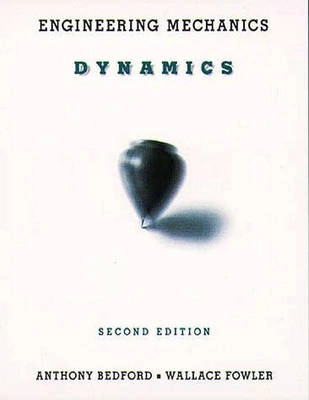This text presents the foundations and applications of statics by emphasizing the importance of visual analysis of topics-especially through the use of free body diagrams. This text also promotes a problem-solving approach to solving examples through its strategy, solution, discussion format in examples. Bedford/Fowler further includes design and computational examples that help instructors integrate these ABET 2000 requirements.
FEATURES/BENEFITS
NEW Strategy-Solution- Discussion Most examples follow this format. Promotes students thinking critically about the example vs. rote memorization. NEW Engineering Design Includes "Application to Engineering" examples that provide discussions of the uses of dynamics in engineering design. NEW Emphasizes Application Text places dynamics within the context of engineering practice by including applications from many fields of engineering. NEW Optional Student Software Working Model-based Simulation Software specifically for Bedford/Fowler. NEW Computational Mechanics Examples Provide optional self-contained examples designed to introduce students to the use of computers in engineering. Professors can use any programming language, or math solver of their choice. NEW Extended discussion of normal and tangential components (Ch. 2) Includes 3D motion. NEW A revised discussion of reference frames Throughout the text, especially in Chs. 2 and 6. NEW Expanded/improved discussion of several topics e.g., impulsive forces, 2D rigid-body kinematics, D''Alembert''s principle, and angular impulse and momentum. NEW Expanded discussion of 3D rigid body dynamics (Ch. 9) Includes new examples and problems. NEW More than 20% new and revised chapter-end problems. Engineering Mechanics: Dynamics, Second Edition. This book has quickly earned a place in Engineering schools across the country because it teaches engineering mechanics the way a good instructor would
Problem Solving
Uses a "Strategy-Solution-Discussion" problem-solving methodology that explains how to approach problems, solve them, and critically judge the results Contains "Computational Mechanics" feature with examples and problems that introduce the reader to computer applications in engineering mechanics Visualization
Stresses the importance of visual analysis, especially the use of free-body diagrams Develops figures gradually and employs "ghosting" techniques to clarify and emphasize concepts-- emulating the way an instructor teaches Applications
Places engineering mechanics within the context of engineering practice by including applications from many fields of engineering Introduces design principles with the "Application to Engineering" feature using concepts developed in preceding sections of the chapter New Features
Visualization
Provides more free-body diagrams to many of the worked examples Separates most of the diagrams showing velocities, accelerations, and forces into a free-body diagram showing the forces and a kinematic diagram showing the accelerations Content
Extends the discussion of normal and tangential components in Chapter 2 to include three- dimensional motion Includes a revised discussion of reference frames throughout the text, especially in Chapters 2 and 6 Improves the discussion of impulsive forces in Chapter 5 Improves the discussion of 2D rigid-body kinematics in Chapter 6 Expands and improves the discussion of D''Alembert''s principle in Chapter 7 Provides a revised and improved discussion of angular impulse and momentum in Chapter 8 Expands the discussion of 3D rigid body dynamics in Chapter 9 and provides new examples and problems Offers several new examples throughout the text including more of the popular feature, "Application to Engineering" Includes more than 20% new and revised end-of-chapter problems Organization
Presents section on Orbital Mechanics in Chapter 3
Åtkomstkoder och digitalt tilläggsmaterial garanteras inte med begagnade böcker





















